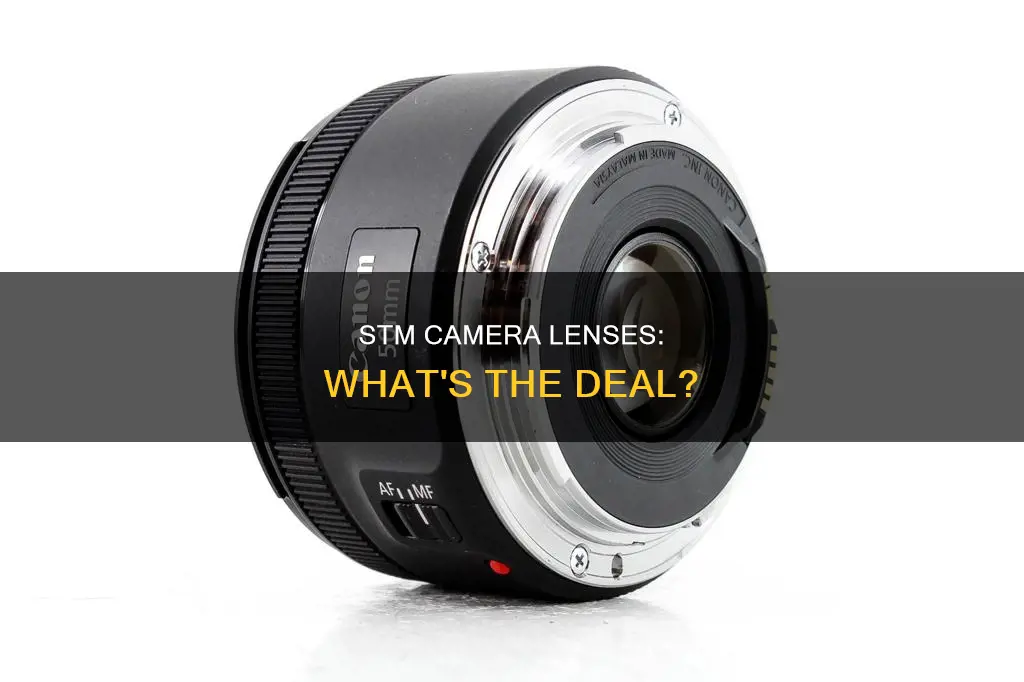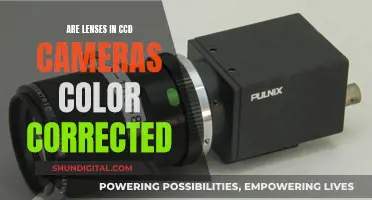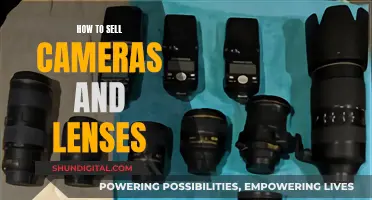
STM stands for Stepper Motor and is a type of autofocus system in Canon camera lenses. Canon introduced this technology to create a quieter and smoother focus system that allows for near-silent focusing during video recording. STM lenses are not as quick to grab focus as USM (Ultrasonic Motor) lenses, but their operation is much quieter. STM lenses are ideal for photographers who require silent shooting or those who want to capture video without picking up lens noise in their audio.
| Characteristics | Values |
|---|---|
| Acronym | STM (Stepper Motor) |
| Type of Motor | Autofocus system |
| Noise | Quiet |
| Focus System | Smooth |
| Focus Ring | Focus-by-wire |
| Use Case | Video recording |
| Manual Focus | Lag |
| Cost | Lower than USM lenses |
| Speed | Slower than USM lenses |
What You'll Learn

STM is Canon's Stepper Motor technology
STM stands for Stepper Motor and is an autofocus system exclusive to Canon camera lenses. Canon introduced the STM technology to create a quieter and smoother focus system that allows for near-silent focusing during video recording.
Canon's first lens with an in-built focusing motor was introduced in 1987. Since then, they have continued to innovate by introducing three types of motors for modern photography: the STM (Stepper Motor), the USM (Ultrasonic Motor), and the more conventional DC type motor.
The STM technology was first introduced in 2012 and provides a more compact solution for photographers who cannot carry around large lenses. The STM system uses a precision stepper motor, which moves in fine increments one step at a time. This allows for very smooth and quiet focus changes, making it ideal for video recording.
Larger STM lenses incorporate a lead-screw type STM system, which is bulkier than the gear-type STM units used in more compact lenses but is faster and quieter in operation. The STM lenses use a "focus-by-wire" system, which means that the movement of the focus ring sends a signal to the motors to electronically change the focus position. This results in a loss of the tactile nature of regular mechanical focus systems.
STM lenses are a great choice for photographers who require smooth and quiet autofocus capabilities, especially for video recording. They are also more affordable than their USM counterparts, making them a popular option for budget-conscious photographers.
Mirrorless Cameras: Capturing Why and How with Interchangeable Lenses
You may want to see also

STM is exclusive to Canon cameras
STM stands for Stepper Motor and is Canon's exclusive technology for a quieter and smoother focus system that allows for near-silent focusing during video recording. Canon introduced this motor design as their lenses were first designed many years ago when DSLRs could not shoot video, so there was no need for them to be extremely quiet.
Nowadays, Canon’s DSLRs and mirrorless cameras shoot video, and they also have the Cinema EOS line of movie cameras, which also use the same EF Mount lenses. Canon's early EOS included two types of autofocus motors, one of which was the USM (ultrasonic motor) design. Canon USM lenses use ultrasonic vibrations to power the autofocusing mechanism, and this has several advantages. First, USM lenses are fast and perfect for action, wildlife, and bird photographers. Second, they allow for manual focusing by turning the focus ring, and the focusing elements inside the lens follow suit.
Canon's STM lenses, on the other hand, can come with some manual focusing lag as there is no mechanical coupling to the focus ring. They are also slower than USM lenses. However, STM lenses are much quieter than their USM counterparts, which makes them excellent for video. The STM, or stepping motor, design was introduced to tailor to the needs of videographers, though they are still adequate for still photographers.
Canon has also created a Nano USM lens, which combines the speed of USM with the quietness of STM.
Mastering the Art of Pronouncing Camera Lens Names
You may want to see also

STM is designed to minimise autofocus vibrations and noise during video recording
STM stands for Stepper Motor, and it is a type of autofocus system found in Canon lenses. STM lenses were introduced in 2012, and they are designed to minimise autofocus vibrations and noise during video recording.
When Canon first designed their lenses many years ago, DSLRs could not shoot video, so there was no need for the lenses to be quiet. Nowadays, Canon's DSLRs and mirrorless cameras can shoot video, and they also have the Cinema EOS line of movie cameras, which use the same EF mount lenses. As a result, Canon developed STM lenses to address this new need for quiet lenses that can deliver smooth and quiet autofocus performance during video recording.
The STM system uses a precision stepper motor, which moves in fine increments one step at a time. This allows for very smooth and quiet focus changes, making it ideal for video recording. The stepper motor uses DC (direct current) passing through multiple coils organised into groups. By supplying current to these groups in a specific sequence, the motor rotates one step at a time, enabling precise movements.
Larger STM lenses use a lead-screw type STM system, which is bulkier than the gear-type STM units found in more compact lenses. However, the lead-screw type offers faster and quieter operation. Canon's STM lenses also use fly-by-wire focusing, which means that turning the focus ring does not physically move the elements. Instead, it sends a signal to the motors to electronically change the focus position.
Overall, Canon's STM lenses are a great choice for videographers looking for smooth and quiet autofocus performance. They are also more affordable than their USM (Ultrasonic Motor) counterparts, making them a popular option for those on a budget.
Olympus 4/3 Camera Lenses: Discontinuation and What's Next
You may want to see also

STM lenses are compact and quiet, but slower than USM lenses
STM stands for Stepper Motor or Stepping Motor, and it is a type of autofocus system used in Canon camera lenses. STM lenses are known for being compact, quiet, and smooth, making them a popular choice for videographers. However, compared to USM (Ultrasonic Motor) lenses, STM lenses are slower in terms of autofocus speed.
Compact and Quiet
STM lenses are known for their compact size, which is advantageous for photographers who need to travel light or work in tight spaces. This compact design is achieved through the use of smaller motors and gears that rotate the focusing element and ring. The geared system in STM lenses results in a smooth and nearly silent autofocus operation, making them ideal for video recording. Canon introduced STM technology to address the noise issues associated with USM lenses, which produce slight noise during autofocusing due to the quick movement of lens elements inside.
Slower Than USM Lenses
While STM lenses excel in quiet and smooth autofocus, they are slower than USM lenses in terms of autofocus speed. USM lenses are designed to focus as quickly as possible, making them the preferred choice for action, wildlife, and sports photographers. The slower autofocus speed of STM lenses can be a drawback for photographers who need to capture fast-moving subjects. However, it's important to note that there are different types of STM implementations, and some lenses with direct-drive STM, like the 24-105, are reported to be just as quick as USM lenses.
Manual Focusing Differences
Another difference between STM and USM lenses lies in their manual focusing capabilities. STM lenses utilize a "focus-by-wire" system, where rotating the manual focus ring sends a signal to the motors to electronically change the focus position. This indirect movement of the focusing elements results in a slight lag during manual focusing. In contrast, USM lenses provide tactile manual focusing, allowing direct control over the movement of the lens elements inside.
Cost and Availability
Cost is another factor to consider when comparing STM and USM lenses. Canon USM lenses are generally more expensive than their STM counterparts, making STM lenses a more budget-friendly option. Additionally, STM lenses tend to be more widely available, especially for amateur photographers, as they cater to a larger part of the customer base.
Camera Lenses for Capturing the Beauty of New Zealand
You may want to see also

STM lenses are cheaper than USM lenses
STM and USM are the two autofocus systems available in Canon lenses. STM stands for Stepper Motor, while USM stands for Ultrasonic Motor. The main difference between the two is that STM lenses are quieter and smoother, making them ideal for video recording, while USM lenses are faster and more precise, making them better suited for still photography.
When it comes to pricing, STM lenses tend to be cheaper than USM lenses. This is because USM lenses use ultrasonic energy to rotate their inner elements for focus, which is a more complex and expensive technology. On the other hand, STM lenses use stepper motor technology, which is easier and cheaper to produce.
In addition to the price difference, there are some other factors to consider when choosing between STM and USM lenses. If you are a professional photographer or videographer, the type of lens you choose will depend on your specific needs. For example, USM lenses are better suited for action, wildlife, and sports photography, where quick and precise autofocus is essential. On the other hand, STM lenses are ideal for videography as they provide smooth and quiet focusing, resulting in noise-free videos.
Another difference between the two types of lenses is the manual focus option. STM lenses use a "focus-by-wire" system, which means that rotating the manual focus ring sends a signal to the motor to move the focus elements indirectly, resulting in some lag during manual focusing. In contrast, USM lenses have a direct mechanical connection between the focus ring and the lens elements, allowing for full-time manual focus without any lag.
In terms of size, USM lenses tend to be bigger than STM lenses. This is because STM lenses were designed to be more compact and lightweight, making them easier to carry around.
Overall, the decision between choosing an STM or USM lens will depend on your specific needs and budget. If you are looking for a quiet and smooth focusing lens for videography, an STM lens is a good option. On the other hand, if you need fast and precise autofocus for still photography, a USM lens is the way to go.
Precision Alignment: Camera Lenses and Their Secrets
You may want to see also
Frequently asked questions
STM stands for Stepper Motor.
STM is Canon's Stepper Motor technology, designed to minimise autofocus vibrations and noise during video recording.
Yes, STM is exclusive to Canon.
STM uses direct currents to gradually rotate the motors, allowing for smooth and quiet autofocusing.
STM is ideal for video recording due to its quiet and smooth autofocus capabilities.







